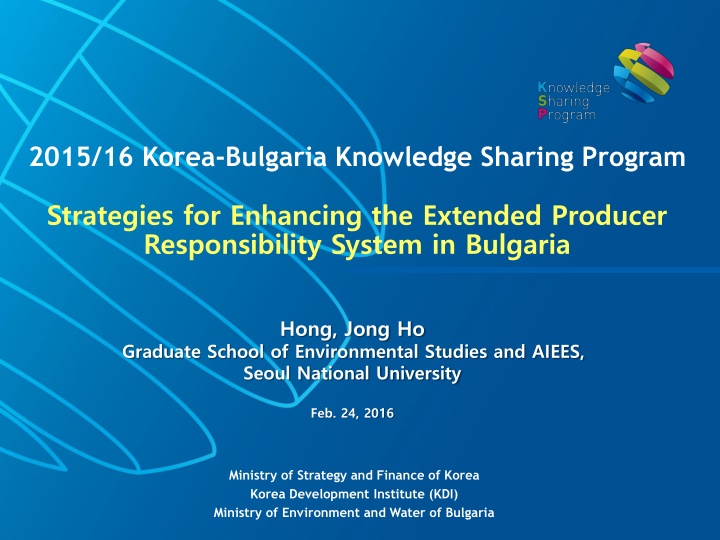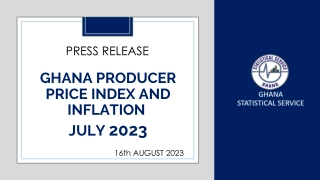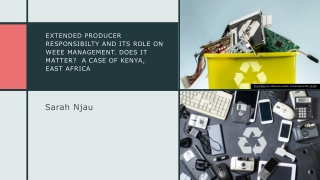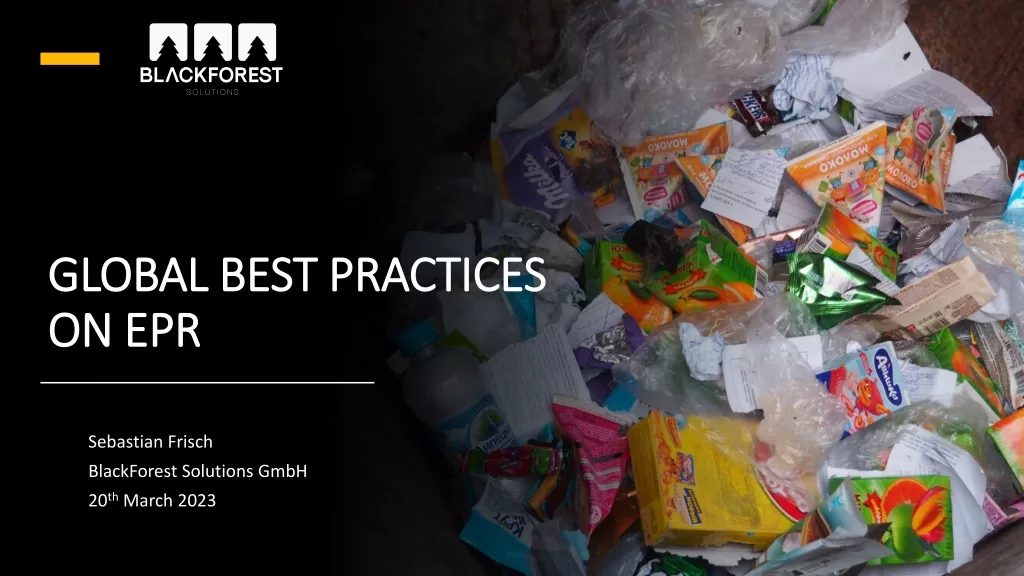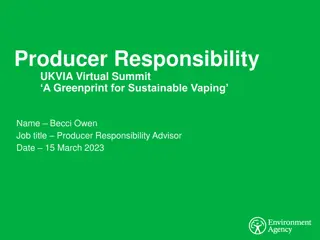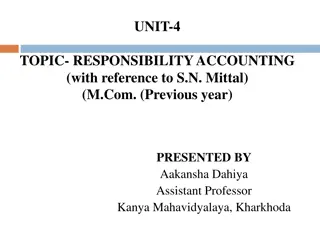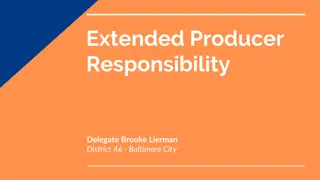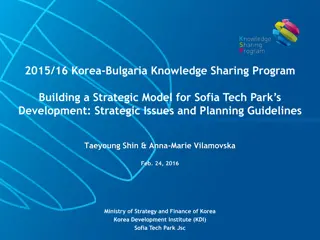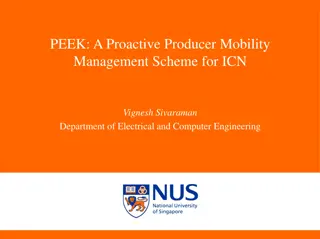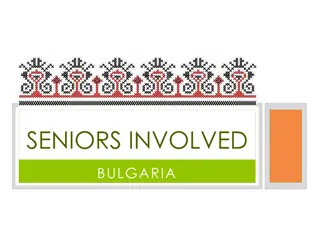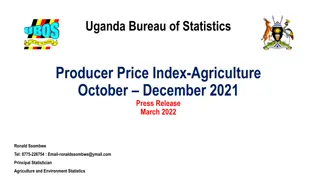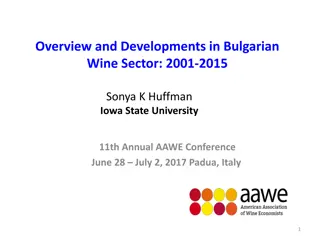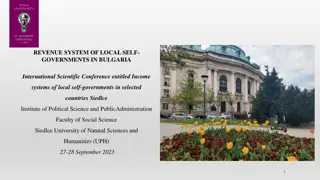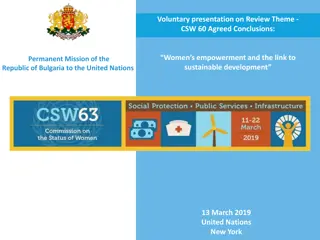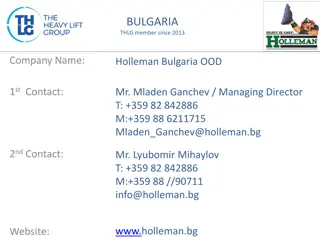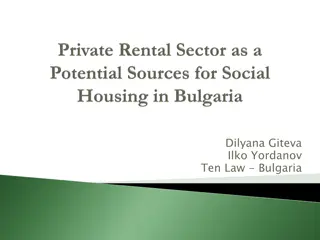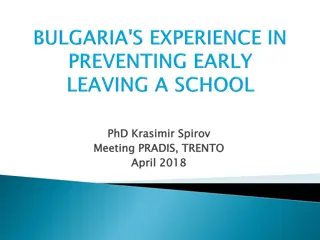Strategies for Enhancing Extended Producer Responsibility System in Bulgaria
Korea-Bulgaria Knowledge Sharing Program focused on sharing strategies to enhance Bulgaria's Extended Producer Responsibility (EPR) system. The program discusses the current status, performance evaluation, issues, and recommendations related to the EPR system in Korea. It covers topics like beverage container deposit system, producer-based deposit refund system, and volume-based waste fee system. Recommendations are provided to improve the effectiveness of Bulgaria's EPR system.
Download Presentation

Please find below an Image/Link to download the presentation.
The content on the website is provided AS IS for your information and personal use only. It may not be sold, licensed, or shared on other websites without obtaining consent from the author.If you encounter any issues during the download, it is possible that the publisher has removed the file from their server.
You are allowed to download the files provided on this website for personal or commercial use, subject to the condition that they are used lawfully. All files are the property of their respective owners.
The content on the website is provided AS IS for your information and personal use only. It may not be sold, licensed, or shared on other websites without obtaining consent from the author.
E N D
Presentation Transcript
2015/16 Korea-Bulgaria Knowledge Sharing Program Strategies for Enhancing the Extended Producer Responsibility System in Bulgaria Hong, Jong Ho Graduate School of Environmental Studies and AIEES, Seoul National University Feb. 24, 2016 Ministry of Strategy and Finance of Korea Korea Development Institute (KDI) Ministry of Environment and Water of Bulgaria
Table of Contents 1. Current Status of Korean EPR 2. Performance and Evaluation of Korean EPR 3. Issues and Recommendations - System-Related - Regulation-Related - Culture and Education-Related - Economic Incentive-Related 4. Further Analysis of WEEE Attachment Issue 5. Concluding Remarks 2
Beverage Container Deposit System Container refund from 1985~ Handling fee from 2003~ Consumer-based deposit-refund system Failure to refund 80% of deposits to customers results in surcharges up to 30% Volume Under 190ml Container Refund Handling Fee 20 KRW/bottle 8KRW/bottle 190~400ml 40 KRW/bottle 16KRW/bottle 400ml ~ 1000ml 50 KRW/bottle 19KRW/bottle 100 KRW/bottle 300 KRW/bottle Over 1000ml 23KRW/bottle
Producer-based Deposit Refund System Background Base Law Responsibilities Weaknesses Items Producer deposit 1992~2003 Act on the Promotion of Savings and Recycling of Resources Low Collection Rate (from 0.06% in 1994 to 7.8% in 1998) Home appliances refund (after recycling) Recycling after consumption Article 18 Deposit = Value of delivered goods in the previous year Deposit Rate Collection cost Packaging Containers Return =Deposit + Interest rate accrued during deposit period Complicated process battery, tire, engine oil fluorescent lamp * Volume based fee system for municipal wastes(WBF) (1995)
Volume-Based Waste Fee (VBWF) System Background Policy Implementation Outcome Introduced in 1995 Households pay for plastic bags of different sizes Cost saving in transportation, reclamation and incineration Pay as you throw principle Savings up to KRW 10,711,411 mil. (1995~2011) Households purchase sticker from regional government office for large home appliances Co-exist with free collection system on demand Introduced in 2014 Weight-based fee system for food wastes using either plastic bags or RFID technology Automatically calculating exact household food waste and charge accordingly -> direct incentive for less food waste 6
VBWF System plastic bags http://www.cjsori.com/imgdata/cjsori_com/201512/2015122728178407.jpg http://ph.idomin.com/news/photo/200802/245005_190608_5012.jpg 7
Extended Producer Responsibility System Background 2003~ Base Law Responsibilities Producer collects WEEE for free Weakness Vehicles excluded Items Act on the Promotion of Savings and Recycling of Resources Article 16 Refrig., TV, wash. machine, A/C, audio, mobile phone, PC printer, copier, fax machine added (2006~) Packaging Containers EEE regulated separately form 2008 Collection upon purchasing new item Compliance with yearly recycling targets (%) Rapidly changing tech products Only 7 types of WEEEs included Producer Responsibility All stages of material flow 90% of obliged producers are member of one PRO (KPRC) Recycling charge when noncompliant metal can, fluorescent lamp, lubricant, disposab le bag, batteries cleansers, styrofoa m float, medicame nts and cosmetics, anti-freezing soluti on Korea Association of Electronics Environment
Eco-assurance System Background 2008~ Base Law Responsibilities Collection of large WEEE free of charge any time Weakness Unaccounted, unauthorized, informal sector Illegal exporting, etc. Items Act on Resource of Electrical and Electronic Equipment and Vehicles Article 15 Home appliances, cars To restrict hazardous materials Compliance with yearly recycling targets (%->kg from 2014) Recycling charge when noncompliant vending machine, perso nal computer, printer, c opier, fax machine, mo bile phone, audio office appliance, electric water purifier, electric o ven To facilitate recycling of EEE and vehicles 90% of obliged producers are members of one PRO (KERC) Low recycling rate compared to EU Producers reveal WEEE toxicity (Cadmium <100ppm, other heavy metals<1000ppm) 95% recycling obligation rate for vehicles (from 2015) electric rice pot, water s oftener, humidifier, elec tric iron, mixer, vacuum machine, video player microwave, food proces sing machine, dish drier , electric bidet, air purifi er, electric heater
Target Management System for WEEE Background Base Law Targets WEEE Collection Channels 2014~ Act on Resource of Electrical and Electronic Equipment and Vehicles 2.9 kg/person (2013) multiple collection channels including free household collection system for WEEE in major cities/nationwide Per capita recycling target Attachment 3 3.9 kg/person (2014) Korea Electronic Recycling Cooperative, municipalies To enhance recycling performance 4.5 kg/person (2015) Electronics shops 6 kg/person (2018) EU: 7.1kg/person (2010)
Stakeholder Responsibilities Government Corporations Recyclers Institutions: Ministry of Environment, Korea Environment Corporation, Local Municipalities Institutions: Producers/Importers > recycling responsibility, Sellers & producers/importers-> collection responsibility Responsibilities: Take measures to recycle of WEEE; penalty=130% of recycling cost otherwise Institutions: Electronic equipment crushing recyclers, crushed residue recyclers, waste gas recyclers Responsibilities: To record information in EcoAS database on recycling volume Responsibilities: To create relevant rules, yearly targets; track the performance of obliged parties
Recycling and Collecting Responsibilities Collecting Responsibility Recycling Responsibility Seller Manufacturer (previous year s sales over 1 billion) (previous year s sales over Importer (previous year s sales over 0.3 billion) 5 billion) Must Collect WEEEs for free upon purchasing new item (Article 16)* Creates Collection System of WEEE (Article 5)* *Source: Act on the Resource Circulation of Electrical and Electronic Equipment and Vehicles
Recycling obligation rate for WEEE EEE 2003 2004 2005 2006 2007 2008 2009 2010 2012 2013 Television 11.6 9.2 11.8 12.6 13.3 14.5 16.0 19.0 27.2 36.2 Refrigerator 9.0 10.8 14.1 16.9 17.3 18.9 20.6 22.1 26.7 34.3 Washing Machine Air conditioner 25.3 21.8 21.2 23.4 24.2 25.3 26.1 27.4 31.7 38.8 0.7 0.7 3.6 1.7 1.9 2.1 2.3 2.4 2.7 8.8 PC 3.8 5.4 8.5 9.4 9.8 10.3 11.1 12.3 15.3 22.9 Audio - - 10.2 12.7 13.1 14.9 15.5 17.0 20.0 26.8 Mobile phone - - 11.9 15.4 16.5 18.0 19.8 22.0 35.6 39.9 Printer - - - 8.4 9.2 11.2 11.9 13.0 15.0 21.8 Copier - - - 8.4 9.4 12.7 13.3 14.2 16.0 23.4 Fax machine - - - 8.4 9.4 11.4 12.1 13.4 15.6 22.3
WEEE Recycling by Year 180,000 800,000 160,000 700,000 140,000 600,000 Facsimile Mobile Phone 120,000 Recycled WEEE (tons) Copier 500,000 EEE Sales (tons) Audio 100,000 Printer 400,000 Air Conditioner 80,000 Personal Computer TV 300,000 60,000 Washing Machine Refregirator 200,000 Total E-Waste Produced 40,000 100,000 20,000 0 - 2008 2009 2010 2011 2012 2013 15
Recycling Rate by Type Recycled(tons)/Sales(tons) Recycling Rate/Target Rate (Mobile phone) 60% 56% 140% 50% 120% Refregirator Washing Machine 40% 100% TV 34% Personal Computer 32% 33% 80% 30% 29% Air Conditioner 30% 27% 26% Printer 60% 20% Audio 20% Copier 40% Mobile Phone 10% Facsimile 20% 2% 2% 2% 3% 2% 1% 0% 0% 2008 2009 2010 2011 2012 2013 2014 2007 2008 2009 2010 2011 2012 2013 2014 Source: Korea Environment Corporation(internal source, 2015) 16
WEEE Free Collection system 1. Call for collection 4. Collection Date Check Target Consumer Online Reservation 5. Home Collection (using PDA) Large electronic appliances 7. Collection Completion Call Small electronic appliances cannot be collected unless consumer discards over 5 small appliances at a time Public Vehicles 2. Reservation Reception 3.Transportation Reservation Call center Disposal Reservation System Collection is performed on Tuesdays, Thursdays and Saturdays 8. Stock Registration 6. Transporting 15% of WEEE are collected from KERC (35,172 units of collected wastes in 2014) Recycling center Municipality
WEEE Logistics Infrastructure <WEEE Collection Map of Korea> Even before WEEE legislature was passed, Korean companies had been operating region- based collection logistics The remaining 30~40% of e- wastes are collected by municipalities Source: POSA (2009)
Samsung WEEE Recycling History 13 Recycling Centers present (8 for Large WEEE, 5 for Small WEEE ) 05 Supply of Small WEEE to Social Enterprises(Recycler) for free 00 Voluntary Agreement with the Korean Government (Creation of Regional Recycling Centers and WEEE Recycling Association) 98 First WEEE Recycling Center in Asan 95 Announcement of New Consumer Rights (Environmental Protection) Establishment of free collection logistics 19
Company-led WEEE Recycling Samsung LG Constructed the first large-scale automatic recycling center(RC) in Asan City(1998) Constructed recycling facility for refrigerators and washing machines(2001) Collects WEEE at digital plazas and service centers Collects WEEE through Best Shops and service centers In 2007, Samsung Electronics and LG Electronics operated 439 collecting points with combined collected WEEE accounting for 65~85% of the total WEEE amount
Issues in Bulgarian WEEE management system Mixed Municipal Solid Waste (only 180 municipalities have separate packaging waste collection) Environmental Hazards (health risk from unauthorized dismantling) Insufficient Recycling and Criminal Activities (not knowing the origin or waste promotes burglary; focus on valuable recyclables leaves less valuable items not recycled) Lack of control over Household Waste Activities (discard WEEE into municipal waste or leave by containers) System Regulation Informal Sector (pick WEEE from containers) Lack of Environmental Education & Information (limited group target; inconsistent environmental information by PROs; public is misinformed about recycling) Lack of Compensation for Transportation Costs and Discomfort (5-10 BGN per piece is not enough motivation; reuse of WEEE) Culture & Education Economic Incentive Property-based Tax to Sponsor WEEE Collection (disproportionally small burden of households ) Attachment to Old EEE (due to post-Soviet sentiment)
System-Related Experiences of Korea Junkyards Business Law (1962) -Entitle Police with the power to monitor activities of junkyards -Junkyard owner is required to report the type of products he/she handles, must not have history of imprisonment in past 3 years to get permit Waste Management Law (Act No. 10389, Jul. 23, 2010) -Junkyards over 1000m2 in metropolitan and 2000m2 in other areas are required to be equipped with environmentally friendly facilities for legal dismantling Financial Support for Junkyards Environmental Facilities - Currently considered by the Ministry of Environment Junkyards in Korea are not Allowed to collect or Dismantle WEEE -They are allowed to handle only plastic, paper and iron scraps
Regulation-Related Experiences of Korea Designated and Monitored Disposal Location - Every apartment complex has a security guard that oversees and explains disposal procedure on designated days of week - Security cameras are installed and only people living in that apartment complex are allowed to dispose of their trash - Illegal disposal is penalized by fine up to KRW1,000,000 (about $850) Designs for Separate Waste Collections
Culture and Education-Related Experiences of Korea Environmental Education is Part of General Curriculum - From 1995 environmental education is formally included in elementary, middle and high schools - Environmental education is an elective class in middle schools - Every school requires students to take turns in recycling of waste produced at school - Undergraduate and graduate degrees in environmental-related fields are offered by leading universities - A single PRO facilitates complete and consistent information delivery to households No to Little Attachment to Old Electronics is Present - No incentive for households to keep old appliances when spaces are limited, while free WEEE collection system provided by large electronics companies is available - Households simply do not feel the need for keeping old, malfunctioning appliances
Economic Incentive-Related Experiences in Korea From Property-based Tax to Volume-based Tax - From 1980s to 1995 Korea used property-based tax to fund waste management - Property-based tax does not give incentive for consumers to reduce waste and dispose carefully - Volume-based bags come in sizes from 3l to 100l and prices range from KRW71 to KRW2,285 as of 2013 - Consumers share of cost in implementing volume-based fee system was 24.9% in 2013 - From 1995 to 2009, the policy saved KRW 10,711,424 million in direct landfilling and incineration costs Very few to No Street Containers - To motivate pay as you throw policy, municipal governments reduced the number of street containers from 7,600 to 3,700 in Seoul
Main Policy Recommendations Issue Type Summary System Laws restricting the type of waste, allowed collection location, environmental dismantling requirements for junkyards Initial financial support for junkyards that want to obtain legal permit for dismantling activities Re-evaluate location and reduce amount of curbside containers Enforce supervision (security guard, surveillance cameras, designate recycling waste day of the week) Regulation Culture & Education Make recycling a culture at schools through recycling days Ensure the exposure to environmental issues from kindergarten Promote information dissemination of potential energy and health risks in regard to the extended use and storage of old appliances Shift to volume-based waste fee system Make monetary compensation more attractive (Consider subsidy for handing over old appliances, e.g., Early retirement program, Low Pollution Program for Diesel Vehicles in Korea) Promote free collection by phone call or online Economic Incentives
4. Further Analysis of Household-level Consumption Behavior on EEE in Bulgaria: Preliminary Evidences from the World Bank Survey Data
Data: Bulgaria Multi-topic Survey 2007 Item Summary Producer Gallup International Bulgaria Publisher World Bank Multitopic Household survey 2007 from Living Standards Measurement Study (Household survey program by World Bank) Characteristics The fifth living standards measuring survey conducted in Bulgaria 4,300 randomly selected households via three-stage probability sampling procedure with stratification by urban and rural areas and by region households . Includes household description, migration, health, employment, agriculture, consumption and other valuable information Contains information on household structure, family members, ownership of electronic products, product age, desirable resale price (as stated by the household head), method of acquiring the products, etc. Assumptions Purpose To better understand consumption behavior including possible product attachment on home appliances by Bulgarian households To compare the results with other countries including Korea
Characteristics by Electronics in Bulgaria Need to consider household characteristics for effective WEEE collection and promotion activities
Average Product Age of EEE in Korea Product Age (years) Washing Machine TV Air Conditioner PC Mainframe PC Monitor Mobile Phone Audio Printer 1 2 3 4 2.8 2.5 5.2 4.6 3.6 1.6 3.3 3.8 7.9 3.2 14.8 6.7 7.5 15.2 23.3 17.1 8.6 9.5 24.6 16.8 6.3 29.4 34.3 21.3 9.8 2.3 11.7 7.4 7.3 16 23.4 12.2 5 10.5 12.1 22.9 22.6 26.3 0 14.3 18.2 6 7 8 9.7 8.8 11 3.6 11.7 11.5 5.6 8.1 4.9 5.9 3.1 1.3 5.8 2.3 1.6 0 0 0 2.2 7.9 8.6 7.6 5.5 2.9 9 17.8 10.1 3 2.1 2.4 0 4.6 4.1 over 10 27.1 38.7 22.9 1.9 2.1 0 31.2 2.8 average 7.33 7.65 5.85 3.94 4.06 2.53 6.41 4.21 Source: KAEE survey (2006) 30
Relationship between the Number of Products and Product Age Average Age of Color TVs per Number of Items Owned Average Age of Refrigerator per Number of Items Owned 28.00 30.00 20.00 18.00 18.00 25.00 16.00 average age of the items 11.55 12.35 18.37 average age of the item 14.00 10.93 20.00 12.00 8.91 13.02 10.00 15.00 average keeping years average keeping years 8.00 6.00 10.00 4.00 2.00 5.00 0.00 1 2 3 4 5 0.00 number of units owned 1 2 3 number of units owned
Relationship between the Number of Products and Product Age Average number of TVs for households with and without TVs over 20 years old Average number of TVs for households with and without TVs over 10 years old 1.60 1.55 1.52 1.55 1.55 1.50 Average number of TVs per household Average number of TVs per household 1.50 1.45 1.45 1.40 1.40 1.35 1.29 1.35 1.30 1.32 1.30 1.25 1.25 1.20 1.20 1.15 under 20 years over 20 years under 10 years over 10 years TV age TV age Need to consider household characteristics for effective WEEE collection and promotion activities 32
Household Characteristics by Electronics Type Need to consider household characteristics for effective WEEE collection and promotion activities
Product Age of TVs in a Household in Korea Source: KISDISTAT Household level survey conducted by Korea Media Panel Research (2010) Sample size of 3,085 households Face-to-face interview to extract information of about household characteristics 34
Number of TVs in a household (per income, per number of people) Source: KISDISTAT (Korea Media Panel Research, 2010) Average number of persons per household - Bulgaria : 2.6 persons(2005) 2.4 (2014) (Source : Eurostat) - Korea : 2.69 (2010) 35
Concluding Remarks This study is the result of a close research collaboration between Bulgarian and Korean experts devoted to an in-depth analysis of issues on EPR for WEEE in both countries. The goal of the study is to share experiences of both countries in waste management policies to promote circular economy. We hope that knowledge sharing on the case of Korea in environmental policy, i.e., historical development of waste management policy and current status/issues in implementing EPR for WEEE, can benefit the people, industry, and the government of Bulgaria.
Conclusions We acknowledge the differences in economic and market conditions and governance systems between Bulgaria and Korea, which should be taken into account in considering policy options. A successful implementation of waste management policies will depend on understanding historical and cultural background as well as identifying political and economic contraints and opportunities of a given society.
